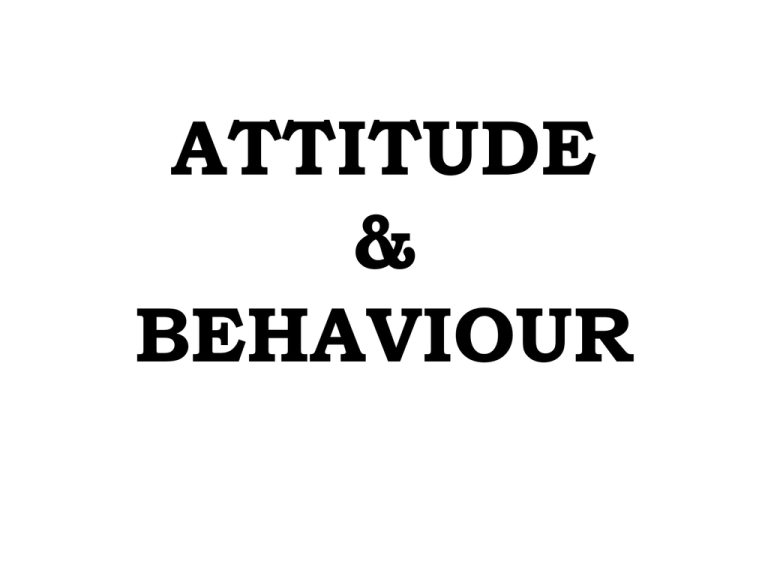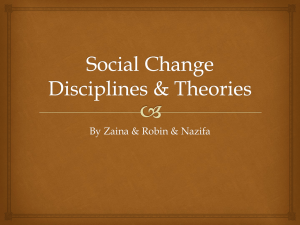Attitude
advertisement

ATTITUDE & BEHAVIOUR What is Attitude? Attitude as defined by Schermerhorn is a predisposition to respond in a positive or negative way to someone or something in one’s environment. When a person says he likes or dislikes something, an attitude is being expressed. Attitude constitute an important psychological attributes of individuals, which shape their behaviour. It can also be defined as the way person feels about something - a person, a place a commodity, a situation or an idea. It expresses individuals positive or negative feeling about the same object. Attitude may be regarded as varying in several ways:• Direction : - For or against something. • Degree : -Favourableness. To be neutral in attitude is to be in-different to the object. • Intensity: - Degree of confidence. COMPONENTS OF ATTITUDES Cognitive or Informational component Ideas, Belief, Values and Information Affective or Emotional component Feelings of likes and dislikes positive & negative Attitude Attitude Object Behavioural component Tendency to behave FACTORS THAT DETERMINE OUR ATTITUDE Environment Experience Education ENVIRONMENT CONSISTS OF THE FOLLOWING Home : School: Work : Media: Positive or Negative influences. Peer Pressures. Supportive or over critical Supervisor. Television, Newspapers, Magazines, Radio, movies. Cultural back ground. Traditions and Beliefs. Social Environment. Political Environment. IMPORTANT CHARACTERISTIC OF ATTITUDE Attitudes affect behaviour Attitudes are invisible Attitudes are acquired Attitudes are pervasive Attitudes & Belief Attitudes & Values SOURCES OF ATTITUDE DIRECT PERSONAL EXPERIENCE ATTITUDES ASSOCIATION SOCIAL LEARNING FORMATION OF ATTITUDE Psychological factors Family factors Social factors Organizational factors Economical factors Political factors BEHAVIOUR BEHAVIOUR IS AN ACT OR FUNCTION IN A PARTICULAR MANNER/WAY. IF WE IMPROVE BEHAVIOUR WE CAN GIVE INCREASED EMPHASIS ON TEAMWORK, TRUST, OPENNESS AND HELPFULNESS. For Example: If you were interested in improving your tennis serve, you might observe a lot of people and their serves. You would look at the pieces of their serves and BREAK THEM INTO SMALLER/LITTLE PARTS AS - HOW THEY HOLD THEIR RACKET, HOW THEY TOSS THE BALL, WHERE THEY STAND, HOW THEY SWING AND SO FORTH. Once you have identified some of little steps that make the difference between good service and not so good, you thereafter start practicing them one at a time. Similarly, suppose you want to identify the verbal behaviour that make a difference between high performance and low performance. What you will do, observe lot of meetings: CRITERIA FOR BEHAVIOUR ANALYSIS • • • • • It could be measured accurately. It should be easy to understand. It should be distinct from other categories. People could change how often they used it. It could be related to effectiveness of performance. CATEGORIES OF DIFFERENT BEHAVIOURS INITIATING REACTING CLARIFYING Initiating Reacting Clarifying Proposing Seeking Information Supporting Building Giving Information Disagreeing Summarizing Defending/ attacking Testing understanding Bringing in and shutting out are the special process categories. BEHAVIOUR Definition & Examples Behaviour Category Definition Examples Proposing A behaviour that puts forward a new suggestion, proposal or course of action. “Let’s deal with that one tomorrow” I suggest that we reduce the number of security guards by 15%. Building A behaviour that usually takes the form of proposal, but that actually extends or develops a proposal made by another person. Since building is an expansion of someone else’s plan or suggestion, it can only occur after a proposal has been presented. It is not possible to build on another person’s information giving. “.. And your plan would be even better if we added a second reporting stage.” “You suggest that we should try to raise money to buy now. Let me make some suggestions about how we might raise that money” “If I can take that further, we could also use the system to give us better cost control.” Behaviour Category Definition Examples Supporting A behaviour that makes a conscious & direct declaration of agreement with or support for another person or for their concepts and opinions. “Yes, I go along with that” “Sounds okay by me.” “Fine” “I accept that” Disagreeing A behaviour that states a direct disagreement or which raises obstacles & objections to another person’s concepts for opinions. Disagreeing is about issues. “No, I don’t agree with that.” “I don’t like the idea one bit.” “Your third point just isn’t true.” Defending attacking / A behaviour that attacks another person, either directly or by defensiveness. Defending / attacking behaviour usually involve value judgement and often contain emotional overtones. They are usually about people, not issues. “What you are suggesting just won’t work” “That’s stupid” “..and your third point is either stupid or an out-and-out lie!” “Don’t blame me, it’s not my fault, it’s John’s responsibility.” Behaviour Category Definition Examples Testing Understanding A behaviour that seeks to establish whether or not an earlier contribution has been understood. It differs from seeking information in that it is an attempt to ensure agreement or consensus of some kind, and refers to a prior question or issue. “Can I just check to be sure we’re talking about the same thing here?” “Can I take it that we all now agree on this?” Summarizing A behaviour that summarizes or restates, in a compact form, the content of previous discussions or events. “So far, we have agreed a) To take legal action; b) To take it before May; and c) To issue a write up in the chairman’s name Seeking Information A behaviour that seeks facts, opinions, or clarification from another person. “What’s the time?” “Can anyone tell me which page this is on?” “Have you checked that thoroughly?” Behaviour Category Definition Examples Giving Information A behaviour that offers facts, opinions, or clarification to other people. “I remember a case like that last year” “There are at least three down there” Bringing in A behaviour that invites views or opinions from a member of the group who is not actively participating in the discussion. “Jane, have you anything to say on this one?” “All has been very quiet. I wonder whether he has anything he would like to say here.” Shutting out A behaviour that excludes another person or persons, or reduces their opportunity to contribute. Interrupting is the most common form of shutting out. John: “ What do you feel Bob?” Karl: “What I feel is………..” Karl is shutting out Bob. WHY ATTITUDE IS IMPORTANT TO ORGANIZATION BEHAVIOUR • Job Satisfaction Vs. Productivity, Absenteeism Employee turnover • Job Involvement. • Organization Commitment CONSEQUENCES OF NEGATIVE ATTITUDE • • • • • BITTERNESS RESENTMENT A PURPOSLESS LIFE ILL HEALTH HIGH STRESS LEVEL FOR THEMSELVES AND OTHERS. RECOGNIZE PEOPLE WITH A POSITIVE ATTITUDE People with the attitude have certain personality traits that are easy to recognize. They are : • • • • • Caring (Dushron ka khayal Rakhne wale) Confident (Atam Vishwasi) Patient (Dharayawan) Humble (Vinamra) ?????????????????? They have high expectation of themselves and from others. A person with a positive attitude is like a fruit of all seasons. BENEFITS OF POSITIVE ATTITUDE • • • • • • • • Increased productivity. Fosters Team. Solves problems. Improve quality. Makes for congenial atmosphere. Breeds loyalty. Increase profits. Fosters better relationship with employers, employees and customers. • Reduces stress. • Makes for pleasing personality. EIGHT ACTION STEPS TO BUILD POSITIVE ATTITUDE. I. Change focus, look for the positive. II. Make it a habit of doing it now. III. Develop an attitude of gratitude. IV. Get into a continuous education programme. V. Build a positive self-esteem. VI. Stay away from negative influences. VII. Learn to like the needs that need to be done. VIII. Start your day with a positive attitude.







